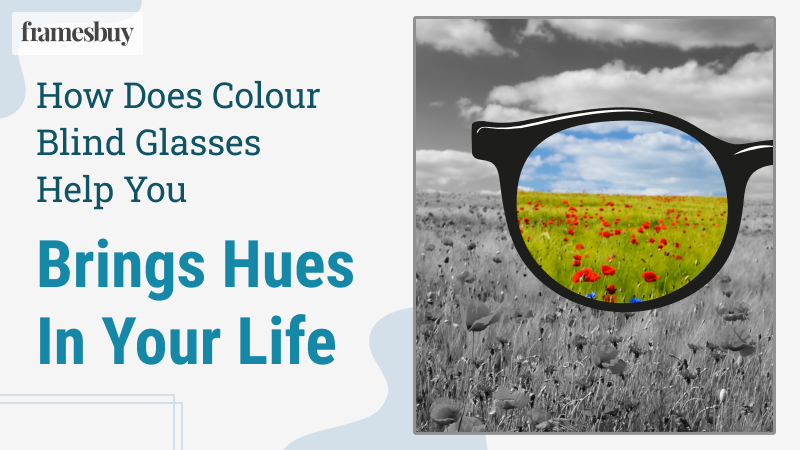Ever been corrected for misinterpreting colours? Are you in doubt that you don’t see how bright a colour is? Has your doctor diagnosed you as colour blinded? It is important to note that the condition is generally rare and genetic, but there is no reason to panic.
In case, you find difficulty distinguishing between different shades, there are colour blind glasses that can enable you to see colours the way they are.
Although they will not cure colour blindness, they can make distinguishing colours easier and experience the world around them in a better way.
What are Colour Blind Glasses?
Colour is a power that directly influences the soul.
~ wassily kandinsky
Before the development of colour blind glasses, there is not much a doctor can prescribe to help your vision. However, with the discovery of special glasses, this has changed. Now a colour deficient person can enjoy better vision with the improvement in the range of visual colour deficiencies.
The uniquely formulated glasses made with a special tint can help a colour-deficient person distinguish hues accurately.
As discussed, these glasses are not the permanent cure for inherent colour blindness. Meanwhile, they only contribute to enabling wearers to better perceive different shades and experience contrast improvement to view the border range of the spectrum. Depending on the type of colour deficiency, these glasses are crafted to improve colour depth, greater perception, and hues distinction.
Types of Colourblind glasses
There are 2 types of colourblind glasses:
Prescription colour blind glasses: For those who suffer from refractive errors (say myopia, hyperopia or presbyopia), colour blind glasses can be customized according to your vision needs.
Non-prescription colour blind glasses: Generally tinted based on your eye need, non-prescription glasses look like sunglasses. They are of great use if you don’t need any vision correction.
How does colourblind glass work?
The most popular glasses for colour blind are made and marketed by EnCroma. Such that here the name itself has become a synonym of colour blind glasses. And there is no surprise that people often ask “how EnChroma Glasses work?”
Since EnChroma and competitive brands for colour blindness made their entry into the optical industry, they have impacted the life of colour blind individuals in many ways. But what is the truth behind them? How do they work? Let’s find out:
Our eye retina contains three receptors often called “cones” (red, green and blue) that enable the eye to distinguish between these colour shades and regularly send the information to the brain to perceive them accurately.
However, sometimes either due to the absence of enough photo-pigment inside these cones or their abnormal functioning, they make detecting colours a challenging task. This leads to abnormal overlapping between some of the light wavelengths that help the brain to determine blue or green colour.
Most often, eye deficiencies result in an inaccurate reading of colours and genetic colour blindness.
This is where colour blindness glasses find application in changing the saturation of object colours viewed through them. The special lens technology uses filters to block out some of the wavelengths between green and red (exactly where the overlapping and confusion occurs in the brain).
Impact of colour correction from colour blind glasses:
Get ready to enjoy a pretty colourful life with colour-blind glasses
While the glasses may bring vibrant colours to your life, this is not true for everyone. Note that each person’s eye and vision deficiency is unique and colour corrective glasses are not one solution that suits everyone.
From the time you start wearing glasses for the first time, one may welcome immediate results. But for some, results may vary or be delayed.
Many people often experience limited benefits from the glasses while others find no difference in wearing them.
To find out, if the glasses are for you or not, take time to read research and studies about them. Visit a doctor to find out the best-fit glasses for colour correction.
Remember these tips before buying colour blindness glasses:
Whether you are buying colour blind glasses or looking for additional information, below are the things to know for the best result:
Wearing the glasses may make your night vision worse:
As the glasses may limit the light reaching your eye, they are not fit for night vision.
Adaptation period just like regular glasses:
Similar to your regular prescription glass, that requires time to adjust. Colour blindness glasses take up to a couple of weeks to fully adjust your eye.
Contrast enhancing glasses and colour blindness glasses are different:
Hunting or contrast-enhancing filter glasses for photography may enhance the contrast but they may not help colour-blind people to distinguish colours accurately.
Expensive and not covered under insurance:
Colour blindness glasses cost higher than other prescription glasses, due to the material used in glasses adding significant cost to the product.
Results may vary depending on deficiency level:
As each person’s colour deficiency may differ, there is a wide range of results and people experience while wearing the glasses.
Amazing Facts About Colour-Blindness:
- Humans are born colour blind until they reach the age of 6 and start seeing the full spectrum of colours. They start distinguishing colours at the age of 20 and after that their colour visuality starts declining.
- Some people with colour blindness only see two bands of colours in a rainbow: yellow and blue.
- Dogs see only different colours in just two bands – yellow and blue.
- Red-green colour blind people face trouble distinguishing between green and brown colours. It makes it hard for them to tell whether the banana is ripe. They are also known to believe that peanut butter is green.
- Be careful of colour-blind drivers on the road who find it difficult to distinguish different colours of traffic lights.
Some Frequently asked questions about Colour Blind Glasses:
There is no known treatment technique to cure colour blindness when you are facing difficulty in seeing different colours. However, if it is acquired or a side effect of any medication or conditions, it can be treated depending on the cause.
Here it should be remembered that wearing coloured filter glasses and coloured contact lenses can enhance your perception to differentiate between different hues of colours. However, these colour contrasting glasses may not improve your ability to see colours.
There is a common misconception that a colour-blind person does not see any colour however, the truth is with the vast range of colours available, there are different types of colour blindness.
Most people with the condition have trouble detecting colours such as green, blue or red. The primary symptom of colour blindness is colour confusion i.e, misunderstanding between brown-coloured peanuts a green coloured.
Alternatives to colour blind glasses:
As we know glasses are not a permanent cure for people who are colour blind. Several kinds of research are going on to help the condition.
Meanwhile, Contact lens options are available to hit the market, Gene therapy to alleviate the inheritance of the condition is currently under research with no product available yet.







